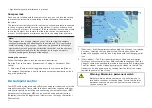
Menu item and description
Options
[Speed input]
(1)
Selects the source for speed data.
•
Auto (default)
•
Water speed
(STW)
•
SOG
•
Default cruise
speed
[Cruise speed]
(1)
Set the Cruise speed value to your vessel’s typical
cruising speed.
•
4.0kts to
60.0kts
[Calibration lock]
The calibration lock is used to lock out specific
calibration settings which if changed may require
recommissioning of the autopilot system. If your system
has been dealer installed then the lock may be turned
on.
•
On (default)
•
Off
[Dockside wizard]
Dockside calibration must be carried out before using
your autopilot for the first time.
The Dockside wizard guides you through the dockside
calibration process.
The steps included in the dockside wizard are
dependent on whether you have a rudder reference
transducer fitted to your vessel.
•
Drive type
•
Rudder limit
•
Align rudder
•
Hard over time
•
Rudder drive
check
[Restart compass]
Select to restart the compass linearization procedure.
•
Start
•
Cancel
•
Disengage
pilot
[Compass lock]
Locks the compass linearization so that further
automatic linearization is not performed.
•
On
•
Off (default)
Menu item and description
Options
[Align compass to GPS]
(1)
Follow the onscreen instructions to align your compass
with your GPS heading.
If your system has a GPS connected to your data
network (SeaTalk, SeaTalkng or NMEA), the autopilot
is tuned to the GPS heading while you steer to a
known magnetic heading. This step provides a rough
alignment and minimizes the amount of compass fine
tuning required. As part of the align to GPS process, the
autopilot system will compare the average heading with
the average COG (Course Over Ground) value reported
by the source of GPS data, and set an offset value so
that the heading matches the COG value provided by
the GPS.
•
Start
•
Cancel
•
Disengage
pilot
[Pilot factory reset]
Resets your autopilot’s settings to factory default values.
•
Yes
•
No
[CCU debug level]
(1)
Sets a debug value for troubleshooting purposes.
The debug level should only be set when requested by
Technical Support as part of a troubleshooting process.
•
0 to 63
[ACU debug level]
(1)
Sets a debug value for troubleshooting purposes.
The debug level should only be set when requested by
Technical Support as part of a troubleshooting process.
•
0 to 63
[Rudder damping]
(1)
Rudder damping is used to prevent the autopilot
from “hunting” maneuvers. Always use the lowest
acceptable value. For more information, refer to:
p.128 — Rudder damping levels and deadband angles
•
1 to 9
•
3 (default)
[Auto turn angle]
(1)
Determines the amount of course change when
performing an auto turn.
•
10° to 125°
•
90° (default)
[Power steering]
(3)
Determines the behavior of the Rotary or Joystick.
•
Off (default)
•
Proportional
•
Bang Bang
126
Summary of Contents for LIGHTHOUSE 4
Page 2: ......
Page 4: ......
Page 20: ...APPENDIX C HARDWARE AND SOFTWARE COMPATIBILITY 478 APPENDIX D DOCUMENT CHANGE HISTORY 480 20...
Page 414: ...414...
Page 451: ...4 Select Delete again to confirm 5 Select OK YachtSense ecosystem 451...
Page 484: ......
Page 503: ......
















































